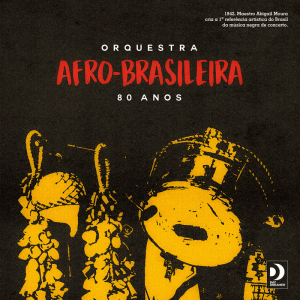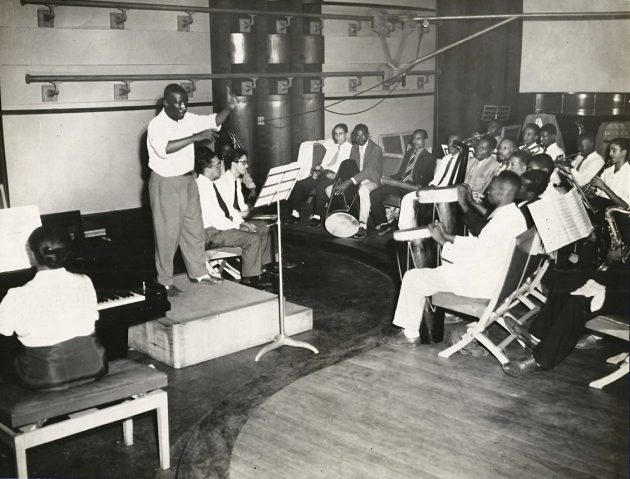
Review Orquestra Afro-Brasileira – Obaluayê! / 80 Anos
Day Dreamer, a new subsidiary of the London-based label Night Dreamer, has posed us one of those “compare and contrast” school exam-type questions from back in the day: Compare and contrast Robespierre’s approach to revolution with that of Marat. That kind of thing. In this case, we can look at a fresh, contemporary release in the light of a long-lost Afro-Brazilian recording from a time just before Brazil won its first football World Cup in Sweden.
The Orquestra Afro-Brasileira was the creation of Abigail Moura, as much a spiritual leader of the outfit as a musician. They appeared on stage together no more than about a hundred times between 1942 and 1970 and left us just two albums, 1957’s Obaluayê! and 1968’s eponymous follow-up. This speed of production is hardly surprising, perhaps, when you learn that Moura would conduct a series of Afro-Brazilian religious rites before each performance, bathing in herbs and purifying the instruments in preparation for the love, devotion and surrender to come. It’s easy to jest, but Mauro’s protégé and the sole remaining member of the 1968 unit, percussionist and vocalist Carlos Negreiros, spells out the importance of the Candomblé rituals and their leader’s message: “I became aware of what it is to be black, discovering the extraordinary potential of the Afro-Brazilian culture in the making of the national ethos.”

The orchestra consisted of around 20 musicians, roughly split between what Mauro dubbed “primitive” percussion instruments and the “civilised” instruments of big band jazz: saxophones, trombones, clarinets and a piano. The nine tracks compressed into the Obaluayê! 10″ LP kick off with “Apresentação de Paulo Roberto”: a kind of sermon on the origins and role of the rhythms and drums brought with them by African slaves. It’s echoed intermittently by a chorus and illustrated by the background percussion that gradually builds to a climax. The other eight tracks fall roughly into two camps, with the final title track appropriately having a foot, so to speak, in both. “Chegou o Rei Congo”, “Amor de Esclavo” and “Babalaô” all employ the percussion instruments alone to reinforce the call-and-response scheme of lead voice answered by chorus. (There’s a potential academic paper waiting to be written in comparing the last of these with hepcat Slim Gaillard’s 1951 “Babalu (Orooney)” to trace its sociological and musical evolution from plantation to city – but I’m not going to volunteer.)
The other four numbers, “Calunga”, “Saudaçao ao Rei Nagô”, “Festa de Congo” and “Liberdade”, bring in the so-called “civilised” big-band instrumentation as a counterpoint to the vocals and percussion. Interestingly, the result in the case of “Festa de Congo” sounds remarkably like Nigerian highlife. These tracks are as thrilling in their way as those of, say, Machito’s early Afro-Cubans. To the ears of a white European outsider, the difference between the two sets of numbers is like that of Mongo Santamaria’s “Afro Blue” and others of a jazzier tinge compared to the conguero’s Yoruba workouts on albums like Bembe. You can appreciate the latter without ever quite immersing yourself in the ritualistic music.
The unembellished percussion of “Albertura” and “Lembarenganga”, the opening and closing tracks of a new album, 80 Anos, the orchestra’s first release for 50 years, ties the release into a historical trilogy by summoning back the spirits of its predecessors. The other eight tracks – including a slightly jauntier re-make of “Saudaçao ao Rei Nagô” – make more use of the “civilised” instruments. They’re coloured by more contemporary arrangements and the deeply spiritual vocals of Carlos Negreiros, who was tracked down by the album’s producer to serve as the catalyst. Funnily enough, when you listen to the gorgeous “Canto Para Omolu-Obaluayê, the timbre of his voice is not a million quavers away from Slim Gaillard’s.
The contrast between the two albums in the spotlight here is largely due to the sophisticated arrangements of Caio Cezar (which at times and especially on “Preto Velho e Yayá” seem to bear the touch of Moondog), and the modern-day techniques of producer, Mario Caldato Jr., whose credits include Marcelo D2 and Seu Jorge. It’s a more consciously musical affair and there’s a sense of restrained latent power as if the orchestra could metamorphose into Bixiga 70 if let off the lease. Caldato talks of the spiritual experience he had on listening to the first two albums. “I was overwhelmed with the percussive rhythms, beautiful deep vocals and combined energy. It felt like the most authentic Brazilian roots music I had ever heard,” he explains. It’s to his eternal credit that he has done such a sensitive job in updating the sound without losing either the feel or the ethos of the original recordings.
Taking these two releases in tandem, Day Dreamer has delivered up a musical treat that resonates with historical and cultural significance. Let’s hope that they will also bring back to light the missing piece of a remarkable jigsaw.
Obaluayê! and 80 Anos are out now on Day Dreamer
Follow Sounds and Colours: Facebook / Twitter / Instagram / Mixcloud / Soundcloud / Bandcamp
Subscribe to the Sounds and Colours Newsletter for regular updates, news and competitions bringing the best of Latin American culture direct to your Inbox.

